

Introduction to Theatre. Last update: January 16, 2009 Realism Resource: Wilson/Goldfarb, Chapter 14Objectives for this lesson: Background The Emergence of Realism Beginnings of the Movement Writers of Realism Other Movements: Background Realism in the last half of the 19th-century began as an experiment to make theater more useful to society.
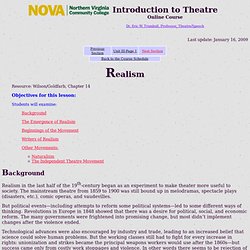
But political events—including attempts to reform some political systems—led to some different ways of thinking. Technological advances were also encouraged by industry and trade, leading to an increased belief that science could solve human problems. {Top of Page} The Emergence of Realism. General Humanities II (Spring 2012): For Wednesday: Act One of Ibsen's A Doll's House. Reading/Discussion Questions for Ibsen's A Doll's House (1879), Act One NOTE: This famous play was originally written in Norwegian, and was later translated into all the major European languages, notably German and English, where it received a massive success/scandal.
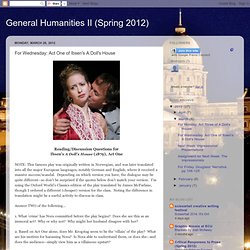
Depending on which version you have, the dialogue may be quite different--so don't be surprised if the quotes below don't match your version. I'm using the Oxford World's Classics edition of the play translated by James McFarlane, though I ordered a different (cheaper) version for the class. Noting the difference in translation might be a useful activity to discuss in class. Modern Theatre, Realism. <hr><p><b>You must have javascript enabled to view this website.

Please change your browser preferences to enable javascript, and reload this page. </b></p><hr> Modern Theatre, Realism The movement that has had the most pervasive influence on modern theatre is realism, the trends toward which began with the rejection of neoclassical form through 18th-century sentimental dramas and comedies and continued in the artistic rebelliousness of Romantic drama. Victorian Etiquette. Interested in what Victorian etiquette used to be?
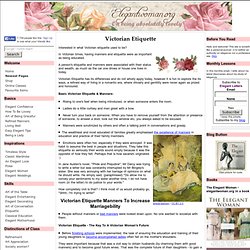
In Victorian times, having manners and etiquette were as important as being educated. A person's etiquette and manners were associated with their status and wealth, as much as the car one drives or house one lives in today. The Crushed Tragedian: WOMEN'S DEPORTMENT - CARRIAGE OF THE ARMS. After a long silence, I've come back to posting.

Being a Victorian in heart and soul, I have no computer at home. Last autumn, I was SHOCKED to discover that my workplace had blocked several sites, including YouTube, Pandora, and Blogspot. Judging from my officemates, though, you still can hit eBay, JibJab, and Rush Limbaugh. But I have discovered a local library with more computer spots than users to fill them, so I gathered up some period photographs to illustrate how graceful Victorian women held their arms.
Even more than dress and speech, bodily deportment, especially the arms, was a mark of a "true lady. " This first photo is from a reenactment group which creates tableaux vivants -- a pastime popular well into the 20th century, until motion pictures killed off the taste. The Modern Theatre: Realism. Janie Jones Homepage / Theatre Arts Department Homepage Lecture Notes Week 8 The Modern Theatre: Realism Key Terms:
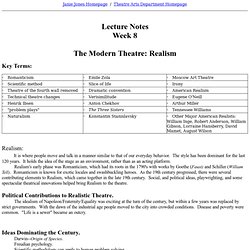
Absurd Drama - Martin Esslin. 'The Theatre of the Absurd' has become a catch-phrase, much used and much abused.

What does it stand for? And how can such a label be justified? Perhaps it will be best to attempt to answer the second question first. There is no organised movement, no school of artists, who claim the label for themselves. A good many playwrights who have been classed under this label, when asked if they belong to the Theatre of the Absurd, will indigniantly reply that they belong to no such movement - and quite rightly so. Yet critical concepts of this kind are useful when new modes of expression, new conventions of art arise. And yet, strangely enough, these plays have worked, they have had an effect, they have exercised a fascination of their own in the theatre. Yet, if tackled directly most of the playwrights in question would refuse to discuss any theories or objectives behind their work. What then is the convention of drama that has now acquired the label of the Theatre of the Absurd?
Commedia dell'arte - Zanni. I Sebastiani-Scenario-Gone Fishing. Welcome to John Rudlin’s Commedia Handbook site! Thank you for visiting the Commedia Handbook site.
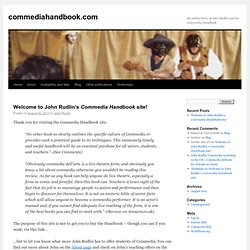
“No other book so clearly outlines the specific culture of Commedia or provides such a practical guide to its techniques. This immensely timely and useful handbook will be an essential purchase for all actors, students, and teachers.” –(See Comments) “Obviously commedia dell’arte is a live theatre form, and obviously you know a bit about commedia otherwise you wouldn’t be reading this review. Theatrical traditions and performance styles « Drama Teacher's Network.
One of the posts that seems to get a lot of views here on the blog is the one on suggestions for teaching the Theatre of the Absurd.
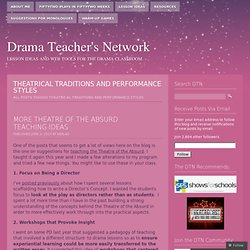
I taught it again this year and I made a few alterations to my program and tried a few new things. You might like to use these in your class. 1. Focus on Being a Director I’ve posted previously about how I spent several lessons scaffolding how to write a Director’s Concept.